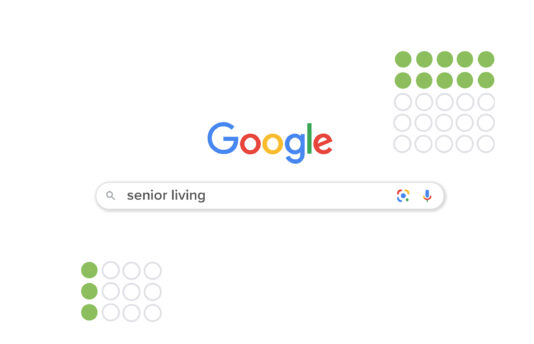Emotion is one of the most effective ways to capture an audience’s attention—and increase engagement. Emotion leads to action, so there are many benefits to including it in your senior living community’s content strategy, including:
- Creating more meaningful relationships with consumers.
- Heightening loyalty.
- Making an excellent first—and more lasting—impression.
- Increasing conversions.
- Compelling people to act.
As any inbound marketing agency will tell you, to attract the most qualified prospects and leads, it’s critical to create engaging content that will trigger an emotional response and get them to act. This could be anything from downloading a brochure, liking a social media post, sharing your content or filling out a form, thus helping you eventually turn prospects into leads and leads into residents.
The Power of Emotion
Emotion is more effective than logic: It’s science. The research of Antonio Damasio, Professor of Neuroscience at the University of Southern California, shows that emotions are central to decision-making. Emotions create preferences, and preferences help us make decisions.
While most of us believe our choices are based on analysis and comparison of options, in truth, emotions have a greater influence on our choices than we’d like to admit. Unfortunately, it’s not unusual for our feelings to override our logic in making choices.
But when it comes to using the power of emotion in marketing, it’s more than a science—it’s also an art. Choosing the right target audience in the right place at the right time is critical, but other variables include the emotion being used, content format, presentation media and brand. The careful crafting of all these components creates what should ultimately be a compelling brand story.
Storytelling Leverages Emotion
Emotion and storytelling are inextricably intertwined. To reach consumers with emotion, there must be a compelling story.
Storytelling involves a narrative that relates to your brand. So, instead of enumerating the benefits of your community, use your senior living marketing to craft a story using real people to explain how their lives have changed because of your community.
Storytelling can be particularly compelling for senior living communities because the target audience may need some help accepting the concept of a retirement community. It’s one of the biggest decisions they will make, and there are some concerns that may hold them back, including:
- They are too young.
- They will be lonely.
- Their home holds all their memories.
- They will lose their freedom.
- They will disrupt a lifestyle they enjoy.
- They will be bored.
Compelling storytelling can go a long way toward reframing the conversation and making senior prospects more comfortable. Using positive words and emotions and highlighting people like them who have transitioned to senior living will help create an emotional connection and build trust between you and your audience.
Six Elements of Storytelling in Marketing
Anyone can paste together a few sentences about their brand. But how do you create a story that’s worth telling? Use these six elements that all lead back to the topic at hand—emotion.
1. Know Your Audience
This may be the most critical part of your efforts. It is essential to know your audience and their passions, concerns, attitudes, beliefs and interests. However, using emotion can be tricky: What makes one person feel joy may not have the same effect on another. Knowing your audience can minimize messaging that doesn’t do what you intend. So how do you do this? Go directly to the source: Resident focus groups are a great place to start. These groups will allow you to test what resonates with the people you already know love your brand, including specific key messaging and visual elements.
2. Be Authentic
Consumers today can sniff out inauthentic messaging and have become distrustful of advertising. In fact, 96% of them don’t believe that ads are truthful. But it’s not surprising in an era of information overload: The average consumer may see as many as 6,000 to 10,000 ads per day. So don’t make outrageous claims; stay true to your brand and leverage real people in your marketing.
3. Show Some Character
If your brand were a person, who would it be? Your people and residents are a big part of your brand, so highlighting them gives a face to your brand. Be truthful. As Jeff Bezos said, “Your brand is what people say about you when you’re not in the room.” Your idea of your senior living brand must match your residents’ idea of your brand.
4. Communicate Clearly
Shed the legalese, industry jargon and business speak—think person to person. Craft your messaging and marketing materials with the tone of a human being, not a company. Think of yourself as a trusted friend who understands your prospects’ unique needs and concerns.
5. Remain Consistent
Make sure all messaging and marketing materials, as well as the way your team presents themselves and responds to residents and prospects, are consistent with your brand standards.
6. Leverage Emotion
This brings us back to where we started. Emotion helps people make decisions, so identify the immediate need that makes people think about the move to senior living. Create messaging to hit those emotional triggers and demonstrate how your community will meet their needs.
Factors in Emotional Marketing
Several factors and tactics can influence the success of your emotional marketing strategy:
Images
Pictures can be easier to understand and recall and more powerful than words. But what if you don’t have the time or budget to host a professional photo shoot? While authentic imagery is always best in senior living advertising, if you need a high-quality picture of a specific scenario that just isn’t coming together in real life, artificial intelligence (AI) can help. Brands like Shutterstock now offer AI-powered image generators that allow you to dream up nearly anything and generate an image to match—just make sure to give it a few test runs to make sure you get the best results. However, please be aware that there are limitations and potential copyright issues that come along with using AI-generated images.
Color
A whole field has grown around color psychology: the study of how color affects human behavior for a reason. That’s because researchers have found that color and emotion are closely connected. Use colors that reflect the sentiment you are trying to evoke. For instance, blue is non-threatening, conservative and traditional, while green conveys prosperity, health and optimism.
Inspiration
Stories highlighting a current resident’s accomplishments can help convince interested prospects that they can accomplish the same things. For instance, a resident who has participated in a 5K may help prospects envision doing the same if they move to your community.
Aspiration
Sometimes, you can create a connection by showing prospects what they can aspire to. Like inspiration, use aspirational images and text to show how residents live a life of comfort, elegance and ease, including leisure activities and beautifully designed homes, demonstrating a lifestyle others may desire.
Authentic, compelling, emotional content can set your community apart. Using real people telling real and relatable stories can help prospects identify with and see themselves in your community.
And while it can be tricky to find the right balance of authentic and over the top when it comes to the power of emotion, when you get it just right, making the extra effort will reward you with more leads and, eventually, more residents.











